Native name Metro Warszawskie Annual ridership 171.26 million (2015) Operator(s) Metro Warszawskie Number of stations 27 (6 under construction) Number of lines 2 | Website Metro Warszawskie Began operation 1995 | |
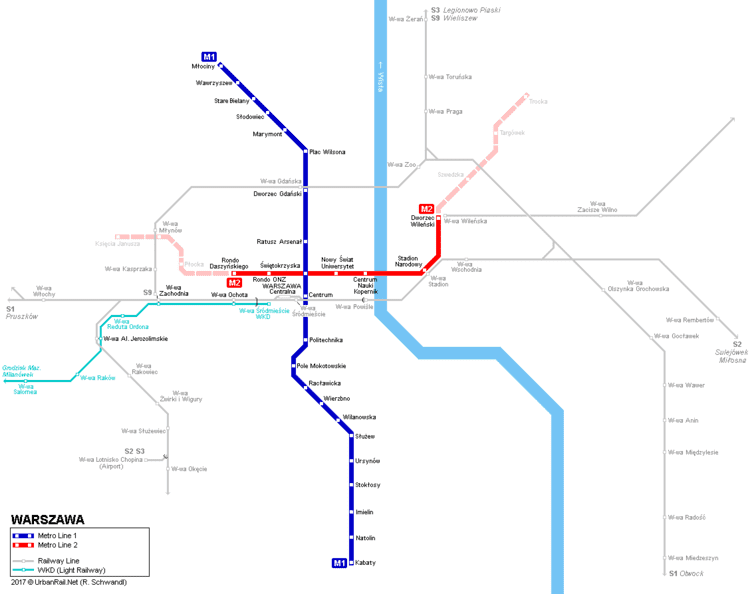 | ||
Daily ridership 568,000(2012, avg. weekday) | ||
Warsaw metro siemens inspiro
The Warsaw Metro (Polish: Metro Warszawskie) is a rapid transit system serving the city of Warsaw, the capital of Poland. It currently consists of two lines, the north–south Line M1 that links central Warsaw with its densely populated northern and southern suburbs, and the initial segment of the east-west Line M2 that opened on March 8, 2015. The second line (M2) is yet to be completed and a third line (M3) is planned.
Contents
- Warsaw metro siemens inspiro
- History
- Rolling stock
- Depots
- Plans
- Current extensions
- Future extensions
- References
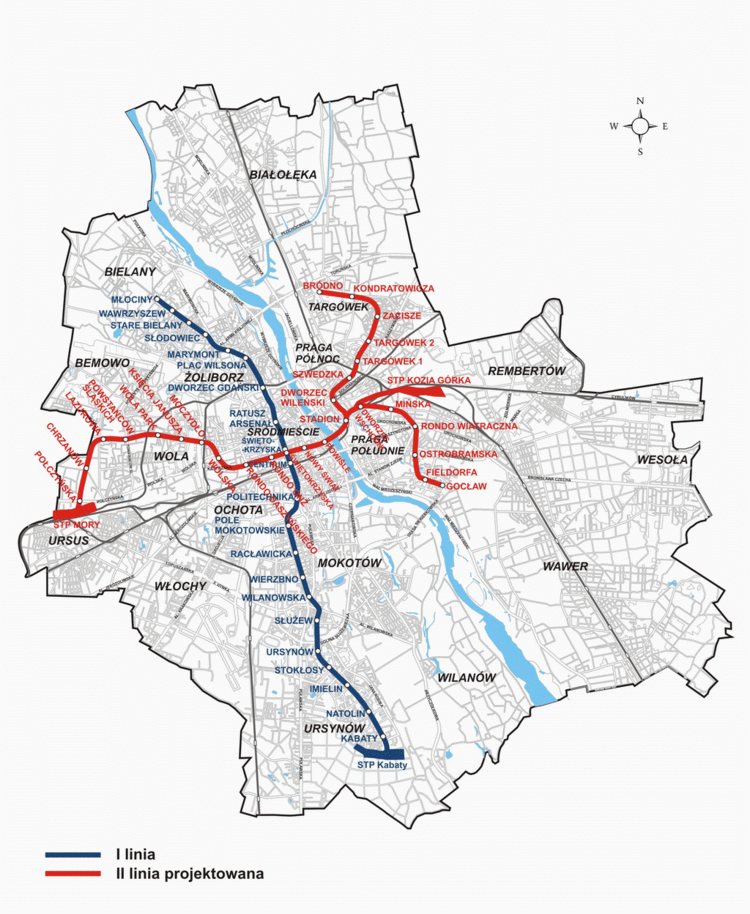
The first section was opened in 1995 and gradually extended until it reached its full length in October 2008. There are additional plans to construct two more stations on this north-south line omitted during initial construction due to costs. The contract for the construction of the initial central section of the second line, running east–west, was signed on October 28, 2009 and construction began on August 16, 2010. This section is 6.3 kilometres (3.9 miles) long (including a tunnel under the Vistula river) with seven stations, one of which (Świętokrzyska) includes a transfer between the two lines.
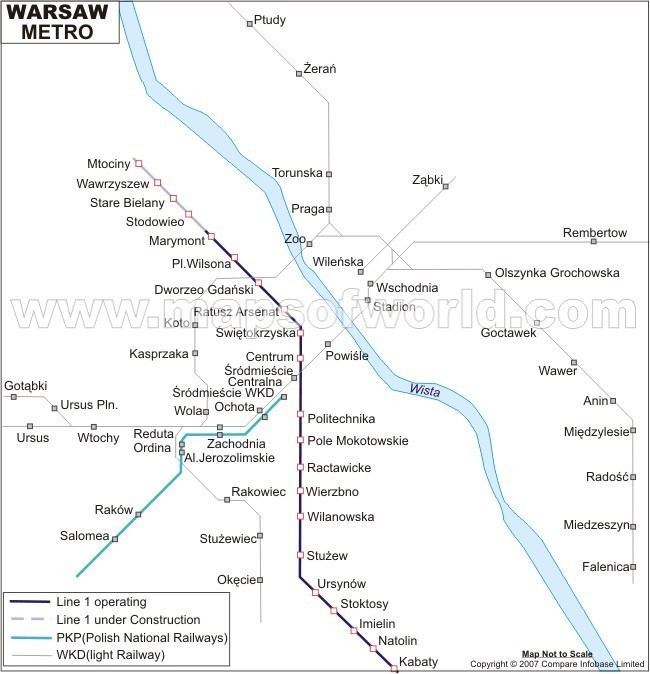
In 2009, the Warsaw Metro won two "Metro Award" prizes in the categories of "Special Merit Award for Commitment to the Environment" and "Best Maintenance Programme". These were followed by the Most Improved Metro award in 2011. The system consistently receives very high ratings among its passengers; a survey conducted in September 2014 indicated that 98% of the respondents rated it good or very good.
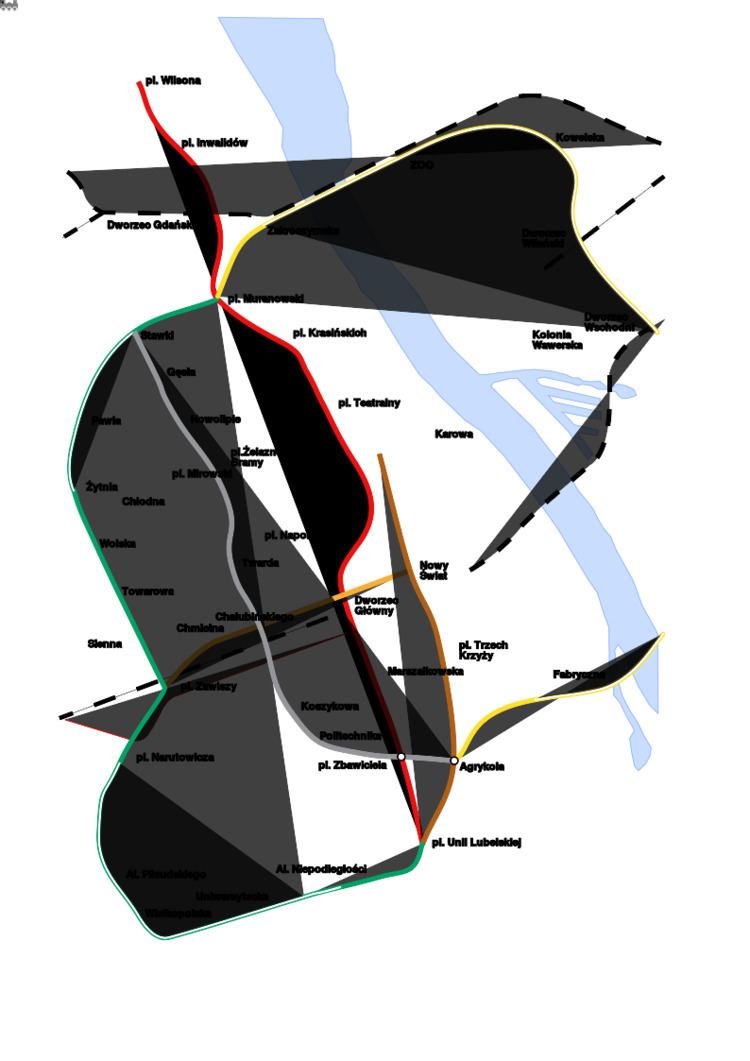
History

Plans to build an underground rail system in Warsaw date as far back as 1918, when the idea was first floated after Warsaw regained its status as Poland's capital city. An underground railway system was expected to solve the transport difficulties of the densely built city centre. Proper preliminary planning and boring work were initiated by the Warsaw Tramway Authority in 1925, with construction expected to start in the late 1920s. The Great Depression buried those plans as Poland and the world was gripped by economic hardship.

In 1934, with the election of a new mayor of Warsaw, Stefan Starzyński, work was to resume on the metro. The mayor dusted off the plans from the mid-1920s, and with some minor adjustments, construction of the metro was planned to start by the late 1930s, with a projected finishing date of the first of two projected lines scheduled for the mid-1940s. By then, the subway network was to consist of two lines. Line 1 (north-south line, 7.4 km or 4.6 mi long) was to follow a route similar to the present-day line and was to link the southernmost borough of Mokotów with the city centre and the northern borough of Żoliborz. This line was to be connected with the newly constructed Warszawa Główna railway station and the railway tunnel crossing the city from west to the east. Line 2 (east-west, 6.36 km or 3.95 mi long) was to start beneath the westernmost borough of Wola, proceed along the Chłodna street to the pivotal station beneath the Saxon Square and then further eastwards to the Vistula river escarpment. There, the line was to go overground, cross the river through a newly built bridge and proceed to the easternmost railway station of Warszawa Wschodnia. Altogether, in 35 years, 7 lines were to be built. The works finally started in 1938, but World War II brought an end to the ambitious undertaking. The short trace tunnels made in 1938 serve as a wine cellar today.
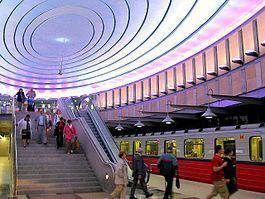
The city suffered heavily during World War II. Although the majority of pre-war projects perished during the war, most of the engineers behind their creation survived and returned to their city to take part in its rebirth. However, the new Communist authorities of Poland envisioned a city completely different from what it had been before the war. As the "ideal" communist city, Warsaw was to be decentralized and the need to commute to the city centre reduced. Thus, the Office for the Reconstruction of Warsaw (BOS) commissioned a number of engineers to prepare a project of a fast urban railway (SKM) crossing the city in a deep cutting. Although to a large extent it was to follow the line 1 of the pre-war plans, only the central stations were to be located underground. However, by the end of the decade the project was cancelled. Instead, in 1948 communist planners developed a different concept with the new SKM morphing into a rapid transit line at a depth of up to 15 metres (49 feet). The suggested north-south direction, with three parallel branches of the same line in the city centre, corresponded to the planned development of the city along the Vistula. The works, however, never started and this project was also abandoned.
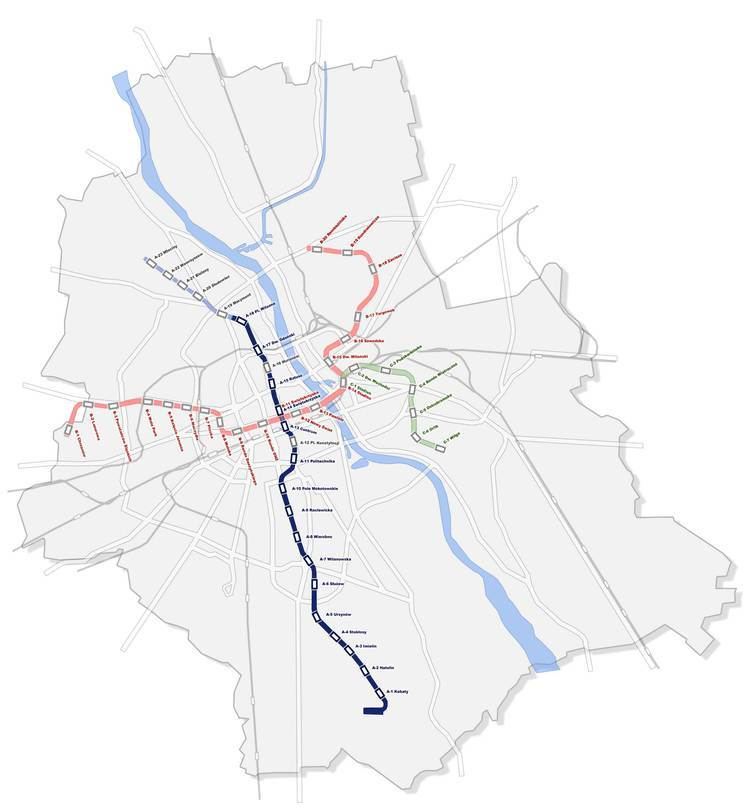
In the 1950s, as the Cold War raged on, Soviet strategic plans required that a secure transport link across the river Vistula be built. One of the ways to achieve this was to create a deep metro system in Warsaw (up to 46 m (150 ft) beneath the ground), which would be interlinked with the rail network and could serve as an underground conduit for transporting troops. Plans assumed that the first line (about 11 km or 7 mi long) would lie along a North-South axis, with a branch of the same line crossing the Vistula river in the city centre. The construction works started almost simultaneously at 17 different points on both sides of the river. By 1953 only 771 m (843 yd) of tunnels had been built; after the death of Joseph Stalin and the start of a period of détente, all work was halted under the pretext of technical difficulties. In the following years, only one junction tunnel and one shield-driven tunnel were continued. These works were undertaken experimentally, in order to discover the best driving methods suitable for the ground conditions beneath Warsaw (pliocene clay formations layer spread beneath quaternary soils). Finally, in 1957, all work was halted.
Since 1955, planners returned to the old idea of a shallow metro network. However, the planning phase proceeded at a very slow pace and the economic situation prevented all successive governments from actually starting serious work. Finally, in 1984, the program was approved by the government and the first tunnels built. Lack of funds, technical difficulties, shortage of materials and outdated tunneling methods meant that the work progressed very slowly, sometimes at a speed no greater than 2 m (6 ft 7 in) per day.
The Metro was opened in 1995 with a total of 11 stations. The initial line, Line M1, has 21 stations over a route distance of 22.7 km (14.1 mi).
Rolling stock
Initially, all of the trains were Russian built. They first arrived in Warsaw in 1990 as a "gift" from the USSR, five years prior to the Metro's opening, from Metrovagonmash plant in Mytishchi (near Moscow) (model 81-717.3/714.3 - 10 carriages). Subsequent trains arrived from Saint Petersburg's Yegorov Plant in 1994 (81-572/573 - 32 carriages) and additional 18 81-572.1/573.1 carriages in 1997.
In 1998, 108 new carriages were ordered from Alstom. These were all delivered by 2005 (24 were produced in Barcelona and the rest in Chorzów). In 2006 additional carriages were ordered from Russia, with deliveries taking place during 2007, to lengthen the existing trains using older Russian carriages.
Currently out of the 40 trains running, 15 consist of the older Russian cars, 7 of the newer Russian cars and 18 of the Alstom-produced cars. The Russian and Alstom carriages are incompatible and cannot be combined in the same train. However, the older and newer Russian cars are interchangeable, with the exception that the cabs on each train must be of the same model at both ends.
In February 2011, an order was signed with Siemens for 35 complete trains from their new Inspiro line. A large number of these were to be manufactured in Poland by Newag. The first 5 of these trains were put into service in 2013. However, in November 2013 a fire broke out on one of them and for safety reasons all five were withdrawn from service until the cause of the fire was determined. Once the investigation was completed the five new Inspiro trains were put back into service in March 2014.
Depots
A single depot is located south of the Kabaty station. There is a single-track connection between the depot and Warszawa-Okęcie station on the PKP rail network. This link is not electrified, and used only for an occasional rolling-stock transfer.
Plans
The first line was a compromise between earlier route proposals further east and west (one of which belonged to the planned Line 4) and as such does not go to some important areas of the city. For example, it does not pass directly under the old town, Warsaw's main tourist attraction, which has few public transport links, passing it about 600 metres (2,000 feet) to the west. It also does not directly connect to the central railway station, with the nearest stop being over 400 metres (1,300 feet) to the east (the second line also avoids it, with the closest station about 400 metres (1,300 feet) to the north). Until the opening of the second line in March 2015, the Metro system was confined to the western bank of the Vistula river, thus doing nothing to ease traffic problems on Warsaw's bridges, a major bottleneck between the city centre and the eastern Praga district. Plans for the third line to Okęcie airport have been abandoned for the foreseeable future.
Transport planners have suggested that the WKD, a light rail line that runs to the western suburbs, could be integrated with the city's tram system, or be more closely tied to the Metro and a future suburban rail network, or both. The first such plans were prepared in the late 1930s and the railway tunnel running below the city centre was to be shared by both the railways and the metro. In the mid-1990s the WKD, PKP and Warsaw Metro systems were temporarily integrated and Warsaw city travel cards were valid also in the suburban railways. This idea was, however, dropped in 1999 due to financial problems.
Current extensions
On March 11, 2016, a 1 billion zł (€225 million) contract was awarded to the Italian company, Astaldi to build the first phase of the North-East second subway line extension with 3.2 kilometres (2.0 mi) of track and 3 stations: Szwedzka, Targówek and Trocka. On April 30, construction on Szwedzka station started, and on May 2, the other two stations started construction. Construction of this phase will take 3 years and will open mid-2019. Initially this extension was to be built at the same time as the west extension but due to delays it was decided that each extension will be built at its own pace.
